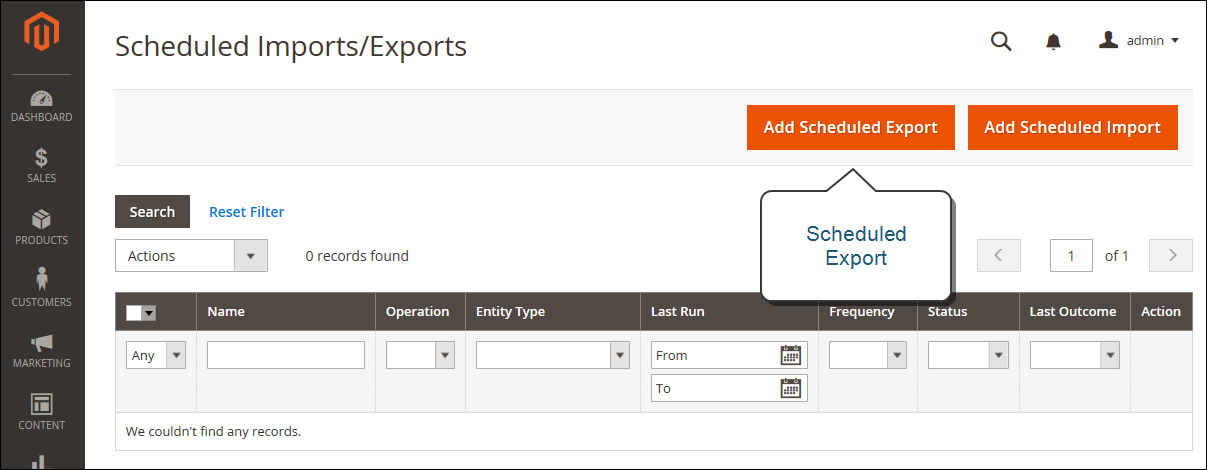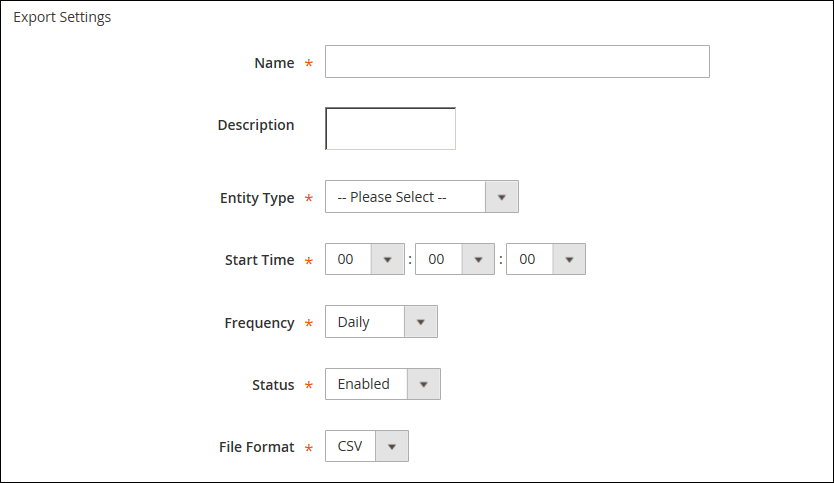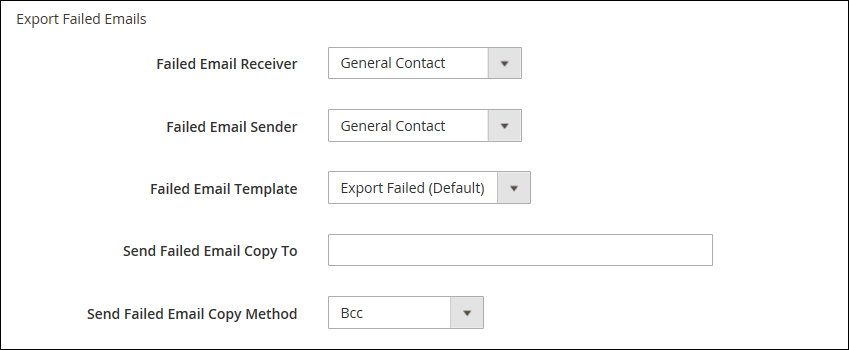Scheduling an Export
Scheduled Export is similar to manual Export, with respect to the available export file format and types of entities that can be exported:
- You can export to CSV format
- You can export product and customer data
The advantage of using Scheduled Export is that you can export data multiple times automatically, after specifying the export parameters, and schedule only once.
 Add Scheduled Export
Add Scheduled Export
The details of each export are not written to a log, but in case of failure you will receive an Export Failed email, which contains the error description. The result of the last export job appears in the Last Outcome column on the Scheduled Import/Export page.
After each export, the export file is placed in the user-defined location, and a copy of the file is placed in the var/log/import_exportdirectory on the server where Magento is deployed. The timestamp and the marker of the exported entity (products or customers) and type of the operation (in this case, export) are added to the export file name.
Step 1: Complete the Export Settings
-
On the Admin sidebar, go to System > Data Transfer > Scheduled Import/Export.
-
In the upper-right corner, click Add Scheduled Export and do the following:
-
Enter a Name for the scheduled export.
-
Enter a brief Description that explains the purpose of the export, and how it is to be used.
-
Set Entity Type to one of the following:
ProductsorCustomersThe Entity Attributes section at the bottom of the page is updated to reflect the selected Entity Type.
-
Set Start Time to the hour, minute, and second that the export is scheduled to begin.
-
Set Frequency to one of the following:
DailyWeeklyMonthly
-
-
To activate the scheduled export, set Status to
Enabled. -
Accept
CSVas the default File Format. Export Settings
Export Settings
Step 2: Complete the Export File Information
-
Set Server Type to one of the following:
Local Server- To save the export file on the same server where Magento is installed.Remote FTP— To save the export file on a remote server.
 Export File Information
Export File Information -
Enter the File Directory where the export file is to be saved as follow:.
- For Local Server, enter a relative path within the Magento installation. For example,
var/export. - For Remote FTP server, enter the full URL and path to the target folder on the destination server.
- For Local Server, enter a relative path within the Magento installation. For example,
Step 3: Configure the Export Failed Emails
-
Set Failed Email Receiver to the store contact who is to receive notification if an error occurs during the export.
-
Set Failed Email Sender to the store contact that appears as the sender of the notification.
-
Set Failed Email Template to the template that is used for the notification.
-
For Send Failed Email Copy To, enter the email address of anyone who is to receive a copy of the notification.
For multiple email addresses, separate with a comma.
-
Set Failed Email Copy Method to one of the following:
Bcc- Sends a blind courtesy copy. The name and address of the recipient is included in the original email distribution, but is hidden from view.Separate Email— Sends the copy as a separate email.
 Export Failed Emails
Export Failed Emails
Step 4: Choose the Entity Attributes
-
In the Entity Attributes section, choose the attributes that you want to include in the export data.
- To filter export data by attributes value, enter the attribute value in the Filter column.
- To exclude products or customers with certain attribute values, enter the values of the attributes that you want to exclude, and select the checkbox in the Skip column.
-
When complete, click Save.
The new scheduled export job is added to the list on the Scheduled Import/Export page. From this page it can be run immediately, for testing, and edited.
Field Descriptions
Export Settings
| Field | Description |
|---|---|
| Name | The name of the export. Helps you to distinguish it if many different scheduled exports are created. |
| Description | (Optional) A description of the scheduled export. |
| Entity Type | Identifies the data to be exported. After the selection is made, the Entity Attributes appear below. Options: Products /Customers. |
| Start Time | Set the start hour, minutes, and seconds of the export. |
| Frequency | Define how often the export job will be executed. Options: Daily / Weekly / Monthly. |
| Status | A new scheduled export is enabled by default. You can suspend it by setting Status to Disabled. Options: Enabled / Disabled. |
| File Format | Select the format of the export file. Currently only the .CSV option is available. |
Export Settings Information
| Field | Description |
|---|---|
| Server Type | Determines the location of the export file. Options: Local Server — Places the export file on the same server where Magento is deployed. Remote FTP — Places the export file on a remote server. Additional options for credentials and file transfer settings appear. |
| File Directory | Specify the directory where the export file is placed. In case Server Type is set to Local Server, specify the relative to Magento installation path. For example, var/export. |
Export Failed Emails
| Field | Description |
|---|---|
| Failed Email Receiver | Specify the email address to which an email notification (export failed email) is sent if the export fails. |
| Failed Email Sender | Specify the email address that is used as export failed email sender. |
| Failed Email Template | Select a template for the failed export email. By default, only the Export Failed (Default Template from Locale) option is available. |
| Send Failed Email Copy To | The email address to which a copy of the failed export email is sent. |
| Send Failed Email Copy Method | Specify the copy sending method for the export failed email. |